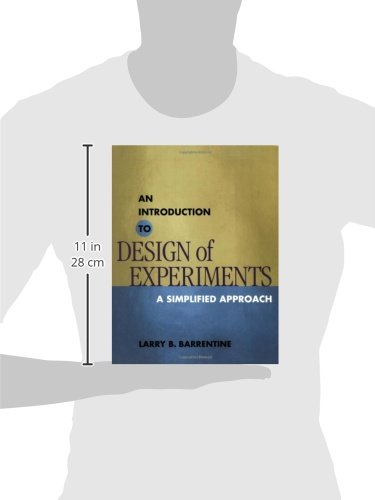Customer Services
Copyright © 2025 Desertcart Holdings Limited
Desert Online General Trading LLC
Dubai, United Arab Emirates



Full description not available
R**.
Just to get you started in the area - very nice for a quick intro to a early class that ...
Very readable, simple, clear, practical and non-threatening. Just to get you started in the area - very nice for a quick intro to a early class that just wants to get their feet wet.
J**H
excellent for first time application
I am conducting experiments with the the intent of optimizing output with 13+ control variables. I have an engineering degree, but we never covered design of experiments method. Prior to reading this book, I was attempting to guess theoretically what outcome I would expect, and then testing the theory. From experience, I knew the results wouldn't quite match up, so I was changing just one variable at a time - then it dawned on me there must be a better way. After some preliminary research, I realized the Plackett-Burman method was what I needed to apply. Most of the material I found too involved and would have required a great deal of time to process. This book had me understanding the method and its limitations after just a few days. It does not explain EVERYTHING - some information it just gives you and explains how to apply it. But that is the trade off to have a resource I was able to start producing meaningful results quickly. Some warnings: watch out for a few typos (especially in the formulas) - recommend doing all the examples to have a handle on the method. Definitely a beginners book for the statistically educated - it begs further research, but is an excellent start if you want to apply it quickly, but want to have SOME understanding as to how it works.
A**L
An Introduction to Design of Experiments: A simplifed Approach
I would consider this an excellent introduction to DOE. Other texts on the subject usually dive right into the deeper levels of statistics at the beginning. This book give the reader a good and straight-forward introduction through simple examples which sets the stage for a more indepth study.
J**E
DOE step by step with examples
DOE is the set of process improvement tools for studying more than one factor in a single experiment. The 92 page book is straight forward with many examples to show the methodology for setting up 2, 3 and up to 31 factor experiments which according to the author will cover >90% of the DOE requirements.The workbook is filled with case studies and examples from manufacturing problems which guide you through the process and help evaluate your understanding before moving to the next section. The mathematical/statistical equations are a bit intimidating but these can be set-up in a spreadsheet. The author says that these DOE tools can be used on office or sales processes but never gives an example of one.The value in this book is if you are doing a quality or six sigma project. Also, it will be of value if you are working in industries like chemical or mining, where yields are the key to success. The book shows the equations to use, the eight steps for analysis and the logical steps to creating an experiment. Additionally, it includes an appendix with T (95% confidence level) and F (degree of freedom) values which are necessary references if you attempt to do this without a statistical software package.
G**A
Good Stuff
It is a book that explains the basics of DOE in a ver understandable way. The seller shipped the book as described and it was a very fast shipment.
P**L
Excellent Book
I knew nothing about DOE until reading this book. As an operations manager struggling to discover the cause for various yield problems this book was instrumental in my success in solving numerous problems through experimentation.
V**Y
A very beginers book
Bought it as a beginners guide but it is really quite simple. Suitable for secondary school students maybe.
M**N
One Star
I could not make anything out of this book...
A**R
Quite useful book for biginners
Basic concepts are lucidly explained. Quite useful book for biginners.
V**R
Three Stars
better understanding of fundamentals
Trustpilot
2 weeks ago
2 weeks ago